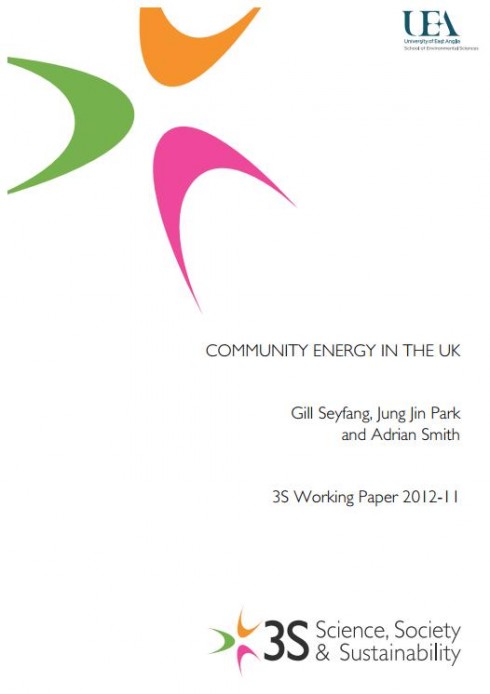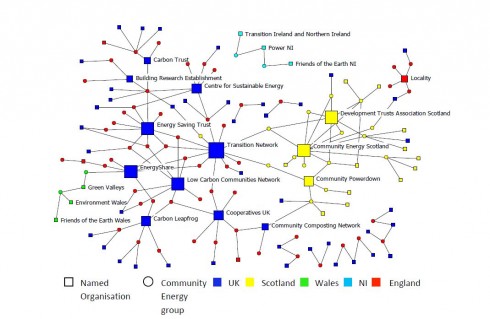17 Oct 2012
New paper identifies the networking impact of Transition Network in the community energy field
 In the context of the fascinating week of posts looking discussing Transition Network over at the Social Reporters’ blog, it was fascinating to read an important new study by Gill Seyfang, Jung Jin Park and Adrian Smith from University of East Anglia about community energy. ‘Community Energy in the UK’ is the first independent UK-wide survey of community energy projects (you can download it here). One of the most interesting things to emerge from the paper is the role Transition Network plays in the field, in spite of being a very small organisation, and it offers some insights into why that might be.
In the context of the fascinating week of posts looking discussing Transition Network over at the Social Reporters’ blog, it was fascinating to read an important new study by Gill Seyfang, Jung Jin Park and Adrian Smith from University of East Anglia about community energy. ‘Community Energy in the UK’ is the first independent UK-wide survey of community energy projects (you can download it here). One of the most interesting things to emerge from the paper is the role Transition Network plays in the field, in spite of being a very small organisation, and it offers some insights into why that might be.
The whole field of community energy has grown greatly in recent years, although the spectrum of what is referred to under the banner of ‘community energy’ is disputed by various researchers. It tends to include both energy generation and energy conservation activities, and they tend to be run by a diverse range of civil society groups, rather than the private sector. For the authors, community energy is:
“… those projects where communities (of place or interest) exhibit a high degree of ownership and control of the energy project, as well as benefiting collectively from the outcomes (either energy-saving or revenue-generation)”.
It notes that there is no central list of these initiatives, rather a variety of organisations (Transition Network included) keep lists of their projects, and this study drew from all of those. Here are what they see as being the three key aspects of community energy:
“First, community energy projects are multi-faceted, and Community Energy in the UK rarely address only one technology or aspect of behaviour in isolation; more commonly, they combine behavioural initiatives with efficiency measures, and both of these with micro-generation, in holistic interventions. Second, by bringing together groups of people with common purpose, they overcome the structural limitations of individualistic measures, by empowering and enabling communities to collectively change their social, economic and technical contexts to encourage more sustainable lives and practise their ideological commitment to sustainability. Third, they enable citizen participation in addressing sustainable energy issues, building on local knowledge and networks, and developing solutions appropriate to local contexts. This can include community development, addressing fuel poverty and local economic development and even emergent experiments in self-governance and participatory democracy”.
They built up a list of all the projects they wanted to survey, and had responses from 354 of them. Of those, having scrutinised the list, they were left with a final sample of 190 projects, which led them to believe “we have achieved the maximum practicable response from the widest range of eligible organisations, and include a diverse set of organisations”.
Here are a few of their findings. Of their sample, 89% saw themselves as being a community of place, i.e strongly rooted in their context. 75% were in England, 18% in Scotland, 4% in Wales and 3% iin Northern Ireland. Two-thirds were in rural locations. 59% were set up by individuals, and 34% by pre-existing community groups. Motivations and objectives were quite varied, the most common being to save money on energy bills, with other motivations being improving energy independence (60%), community empowerment (57%) and generating an income for the community (52%).
So what do they actually do to achieve this? 82% focus on sustainable energy generation, and 86% on energy conservation, with 68% engaged in the two at the same time. Solar PV was the most common energy source, far ahead of the other technologies. In terms of how successful these projects see themselves as being, 75% felt that they were achieving their objectives quite well or very well. Most of them depend on grant funding for their initiatives, only a handful of them had run community share options.
The most fascinating findings from a Transition Network perspective were around networking. The report found that “networking is a key activity for the UK’s community energy sector, almost three quarters (73%) of our survey respondents were engaged in some form of networking with other community energy groups and/or with organisations and networks”. It found that many of these projects support each other, both in offering help to other local groups as well as receiving it.
The other aspect of networking explored was the links these projects had with intermediary organisations and networks. This built up a fascinating picture of the web of organisations, from local networks to national networks, national-scale organisations, public sector and third sector organisations and private organisations. The authors mapped these relationships in what they call a ‘sociogram’ which shows the complexity of these relationships, and who influences who (see below, click to enlarge).
It concludes that “Transition Network was the most commonly named organisation” by respondents, and this is reflected in the sociogram. Given that it is followed in the list by organisations such as the Energy Savings Trust whose resources and size far outstrip Transition Network’s, this is a fascinating taste of the impact of Transition, and of how it works, being as much an idea, a unifying context and identity, a motivating concept and active network, as it is a provider of tangible support in relation to community energy. For an organisation that has been around for only a short time, and whose staff consist of less than 10 people, this is really something to celebrate I feel.
In the report’s conclusions, the point is made that this sector is defined by its eclectic nature, with no ‘one-size-fits-all’ approach, each initiative being particular to the community and setting in question. They conclude that “there is a challenge here for government and the sector to relate to each other more effectively to best achieve the sustainability goals of these groups”. It warns against merely measuring these projects for success merely in terms of carbon saved or energy generated) misses the point if the aim is to capture the full range of outcomes that such projects generate. It also identifies the need to consistent policy support and for the provision of the support that such projects actually need. They conclude:
“… our research has revealed a wealth of civil society activity in the field of sustainable energy, tackling a wide range of sustainable energy and related issues, and growing as a sector. With appropriate policy support and clear funding streams, and robust intermediary organisations to share learning, we are cautiously optimistic that community energy can continue to grow and achieve its potential as a key player in the transition to a sustainable energy system”.
This is a fascinating and timely study, with many useful insights. For me it is a fascinating affirmation of how Transition works not just as an organisation that produces materials, but as a network, as a galvanising concept that offers a useful identity to projects, how some of the support initiatives get is possible because they are part of a self-organising network that shares stories, and sets a context as to why it all matters so very much.
It brings to mind, and for me affirms, what Caroline Jackson wrote in her Social Reporters’ post, ‘What has the Transition Network ever done for us?’ yesterday:
“It’s the connecting that’s important,”
someone else told me, in the midst of a conversation about how we find a new venue for our Sewing Café, now the Library has to charge “market rates”. What she meant was that when she looked on the site she was often after the answer to a problem and through the site she had been able to find names of experts, email addresses or websites and from there to actual people. Unfailingly, she’d found the “actual people” had been generous over email or “brilliantly helpful” by phone and several of them had then come to Lancaster.
What else did the Network ever do for us? Well there’s the inspiration … A number of the people I spoke to were looking for “where next” as individuals, but more often for their group or in the case of Steering Group members, the whole initiative. Lancaster Transition has just set up as a CIC and the germ of inspiration for that came from finding out on the Network what other groups were doing. For some people the fact that others all over the world are doing great things with food and growing or Reconomy or renewable energy arouses a can do spirit, maybe even a healthy sort of competitiveness. The “ordinariness” of the other people involved, the fact that there is no hype, was also commented on:
“If they can do it, we can do it”.

michael Dunwell
17 Oct 4:44pm
Well done everybody! This goes top of the agenda for the next steering group.
ChrisB
17 Oct 6:27pm
This research and the experience of Caroline Jackson when she talks about the generous advice and assistance she receives from the network illustrate a key difference between community projects and corporate developments. My own experience when visiting community renewable energy projects for http://www.renewableenergyblog.org is that people are more than happy to give up their time, share information, provide advice, tea, biscuits and sometimes bed and breakfast!
Businesses, on the other hand, are often stuck in the cut throat world where knowledge is power and to share information could mean losing a competitive advantage. There are exceptions where individuals are motivated by more than just profit and happy to share expertise and experience but all too often secrecy is the norm.
This willingness to share, especially when facilitated by networks such as that provided by Transition, is a powerful asset that we neglect at our peril.
Trish Knox
17 Oct 6:34pm
Without inclusion there is no networking and without networking there is no inclusion. One supports the other in an inter-dependent and dynamic energetic system. Our bodies are an excellent model of how this works…as well as a garden. Nature and Her systems are our best teacher!
Mümtaz Derya Tarhan
19 Oct 12:08pm
Congratulations Transition Network, I’m certain that your impact on community energy through social networking will reach well beyond the UK!
To find out about the latest news on community energy initiatives and policy updates from around the world, you may visit The Community Power Report at http://www.communitypowerreport.com , look it up on Twitter (https://twitter.com/thecpreport) and Facebook (http://www.facebook.com/thecpreport)